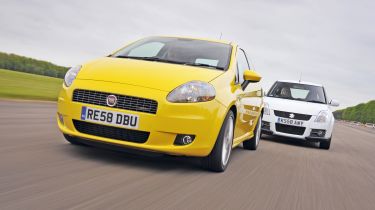Grande Punto 1.4 T-jet vs Swift 1.6 Sport
We bring our final pair together to see if turbo power works in a sporty supermini
If you want to increase power fast, bolting on a turbo is a quick fix. So in theory it should be ideal to use in a small hot hatch. But can the 1.4 T-Jet powerplant fitted
to Fiat’s Grand Punto Sporting match the thrills provided by the normally aspirated 1.6-litre unit in the Suzuki Swift Sport?
Look at the raw figures, and there’s virtually nothing in it. With 123bhp at its disposal, the Japanese supermini has 3bhp more than its Italian rival. However, as with the other pairings here, the turbo model has a torque advantage, with the Grande Punto delivering 206Nm to the Suzuki’s 148Nm. At the test track, the Suzuki sprinted from 0-60mph in only 8.5 seconds – that’s three-tenths faster than its rival.
But this was turned on its head during our in-gear assessments, as the torquey Fiat showed the normally aspirated car a clean pair of heels in both tests. The flexible Grande Punto raced from 50-70mph in fifth gear in 7.6 seconds – an impressive 1.3 seconds faster than the Swift.
Sporty hatchbacks aren’t all about pure speed, though, and the two cars deliver very different driving experiences. While the laid-back Fiat pulls strongly from low down, you need to use all of the available revs in the Suzuki. Its frenetic character is in stark contrast to the more refined Italian model.
Used - available now

2020 Peugeot
508
57,957 milesAutomaticDiesel1.5L
Cash £11,999
2021 Ford
Fiesta
9,955 milesAutomaticPetrol1.0L
Cash £16,699
2023 Ford
Puma
18,363 milesAutomaticPetrol1.0L
Cash £16,899
2020 Ford
Kuga
24,644 milesAutomaticDiesel2.0L
Cash £25,799The Grande Punto repays you with lower emissions and superior combined fuel consumption. It puts out 155g/km of CO2 to the Swift’s 171g/km Swift, so sits in a lower tax band. Owners will pay £150 for an annual tax disc; Suzuki buyers shell out £175. The Japanese car is also more expensive for company drivers, although the gap isn’t huge due to the Fiat’s higher list price. It costs standard-rate business users £18 less each year than the more heavily polluting Swift.
The Fiat enjoys a similarly small advantage at the pumps, although we struggled to get near its combined economy figure of 42.8mpg. On our test it returned 32.4mpg, which was just enough to beat the 31.7mpg Swift Sport. However, the Suzuki comes up trumps on insurance. Its annual premium undercuts its rival’s by a useful £78. The purchase price provides the biggest dent in the wallet, though, and this is where the Suzuki makes even more sense.
At £11,990, it’s £765 cheaper than the Fiat. It doesn’t skimp on kit, either, with climate control – instead of its rival’s air-con – fitted as standard. Yet while you save on the Swift, it’s not as spacious. The Suzuki is smaller than the Punto, with less rear legroom and a much tinier boot. A firm ride and busy engine also make it ill-suited to long trips; the softer and more refined Fiat is a capable motorway cruiser.
Crucially, though, the Swift is more engaging. Its steering provides greater weight and precision, while the stiff suspension serves up sharper responses and tighter body control than the Grande Punto.
The two engines highlight this difference in character. Nothing beats the thrill of driving a car with a highly tuned petrol engine, and the rev-hungry Suzuki can even make a trip to the shops exciting – a priceless quality in a small hot hatch.
The Fiat is a more talented all-rounder, with its relaxed and linear power delivery. Yet it’s not as much fun, and is more expensive and thirstier than the claimed figures suggest.
If you want space and pace the Fiat wins, but for our money the Sukuki is the better junior hot hatch. The normally aspirated car wins this clash.
Environment
Low CO2 emissions of only 155g/km give the Fiat the advantage here. The normally aspirated Suzuki emits 177g/km, which places it one tax band higher, making it more expensive to tax for private and company car users alike.







